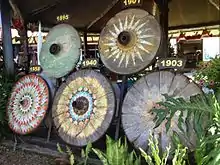Mónica Aguilar Bonilla
Mónica Aguilar Bonilla (born 11 July 1980 in San Jose) is a Costa-Rican archaeologist. She is Professor of Archaeology and Anthropology in the Faculty of Social Sciences at the University of Costa Rica.[1]
Mónica Aguilar Bonilla | |
|---|---|
| Born | July 11, 1980 |
| Nationality | Costa Rican |
| Academic background | |
| Alma mater | University of Costa Rica |
| Academic work | |
| Discipline | Archaeology |
| Sub-discipline | Pre-Columbian societies of Costa Rica |
| Institutions | University of Costa Rica |
Research
Bonilla is an expert in the pre-Columbian societies of Costa-Rica and Costa-Rican archaeology, cultural law and heritage more widely, in terms of both its tangible and intangible assets.[2] She has worked on producing a dictionary of archaeological artefacts from Costa Rica, putting indigenous artistry into context from pre-Columbian times to today.[3] She has studied the potential for the repatriation of over 16,000 artefacts collected by Minor Cooper Keith from the late nineteenth to early twentieth centuries, including 5,000 artefacts acquired by the Brooklyn Museum in the 1930s.[4] There is long history of Costa Rica's heritage being looted for commercial gain.[5] Other research interests include the paleo-environment of Central America,[6] pre-Columbian musical instruments[7] and digital heritage.[8]
Sites
Bonilla has studied the assemblages of material from Las Mercedes, including material collected by Minor Keith, and published a study on how huaqueros and archaeologists can work together to preserve Costa Rica's heritage.[9] She worked to produce the first digital repository of work on the Guayabo National Monument.[10] She has investigated the site of Agua Caliente.[11]

In 2005, El Boyeo y la Carreta (the traditions of ox-herding and making ox-carts) were given UNESCO World Heritage Status (Intangible Heritage), based on a candidacy case prepared by Bonilla.[1] The carreta (oxcart) is one of Costa Rica's most famous crafts, used to transport coffee beans, their wheels are a hybrid of Spanish spokes and Aztec disc design.[12] The UNESCO listing has led to a cultural revival, which has increased tourism.[13]
In 2018 Bonilla began a research project investigating the industrial heritage of Costa Rica for the first time.[14] One of the first areas to be explored is Abangares in Guanacaste, where mineral extraction has been an important industry for two hundreds years and linked to global supply chains.[15] Companies invested in the area whose artefacts are in the archaeological record, included: Cyanide Plant Supply Company, London, England and National Manufacturing Company, Dayton, Ohio, USA.
References
- "Autori Aracne editrice - Mónica Aguilar Bonilla". www.aracneeditrice.it (in Italian). Retrieved 2020-01-01.
- La conservación del patrimonio cultural en Costa Rica. Aguilar Bonilla, Mónica,, Niglio, Olimpia, 1970- (I edizione ed.). Roma. ISBN 978-88-548-5880-0. OCLC 879975105.CS1 maint: others (link)
- Bonilla, Mónica Aguilar; Vargas, Giselle Chang (2009). "Continuidad y discontinuidad en el trabajo artesanal: Experiencias del proyecto diccionario de artefactos arqueológicos y etnológicos de Costa Rica". Cuadernos de antropología: Revista Digital del Laboratorio de Etnología "María Eugenia Bozzoli Vargas". 19 (1): 93–111. ISSN 2215-356X.
- Bonilla, Mónica Aguilar (2011). "De vuelta a casa, no al hogar: devolución de una parte de la colección arqueológica de Minor Keith". Cuadernos de antropología: Revista Digital del Laboratorio de Etnología "María Eugenia Bozzoli Vargas". 21 (1): 11. ISSN 2215-356X.
- Weil, Jim (2007). "Work and Anthropology in Costa Rica: An Orientation". Anthropology of Work Review. 28 (2): 1–8. doi:10.1525/awr.2007.28.2.1. ISSN 1548-1417.
- "Sigpro - EXPLORACIÓN DE LA CONSERVACIÓN Y POTENCIAL DE LOS DATOS PALEO-AMBIENTALES PARA ENTENDER LOS PROCESOS DE CAMBIO BIOCULTURAL EN UN ASENTAMIENTO HUMANO PRECOLOMBINO DEL CARIBE CENTRAL, COSTA RICA". vinv.ucr.ac.cr. Retrieved 2020-01-02.
- Molina, P. y M. Aguilar 2015 La metáfora de los sonidos materialización de la música en las poblaciones precolombinas. Fundación Museos del Banco Central. Masterlitho. San José. ISBN 978-9968-530-27-9.
- Aguilar Bonilla, Mónica (2016-05-02). "El repositorio digital como herramienta para ladivulgación formal e informar del patrimonio cultural". Herencia. 25 (1–2).
- Bonilla, Mónica Aguilar (2007). "The Pothunter's Livelihood: Huaquerismo and Costa Rican Law in Defense of the National Archaeological Heritage". Anthropology of Work Review. 28 (2): 8–12. doi:10.1525/awr.2007.28.2.8. ISSN 1548-1417.
- "Sigpro - REPOSITORIO DE INFORMACIÓN DIGITAL MONUMENTO NACIONAL GUAYABO". vinv.ucr.ac.cr. Retrieved 2020-01-02.
- Herrera, Mauricio Murillo (2011). Precolumbian Social Change in San Ramon de Alajuela, Costa Rica (in Spanish). Center for Comparative Arch. p. 81. ISBN 978-1-877812-90-3.
- Miranda, Roberto, La Tradicion del Boyeo y la Carreta en Costa Rica, retrieved 2020-01-02
- "Tourism and Intangible Cultural Heritage - PDF Free Download". pdffox.com. Retrieved 2020-01-02.
- "Sigpro - ARQUEOLOGÍA INDUSTRIAL: ESTADO DEL ARTE Y PRIMER INVENTARIO NACIONAL". vinv.ucr.ac.cr. Retrieved 2020-01-02.
- "Producción minera en Abangares, Guanacaste. Un punto de arranque de las investigaciones en arqueología industrial en Costa Rica". Cite journal requires
|journal=(help) - "Miembros y Junta Directiva". www.icomoscr.org. Retrieved 2020-01-02.
- "Tesis de maestría" (PDF).